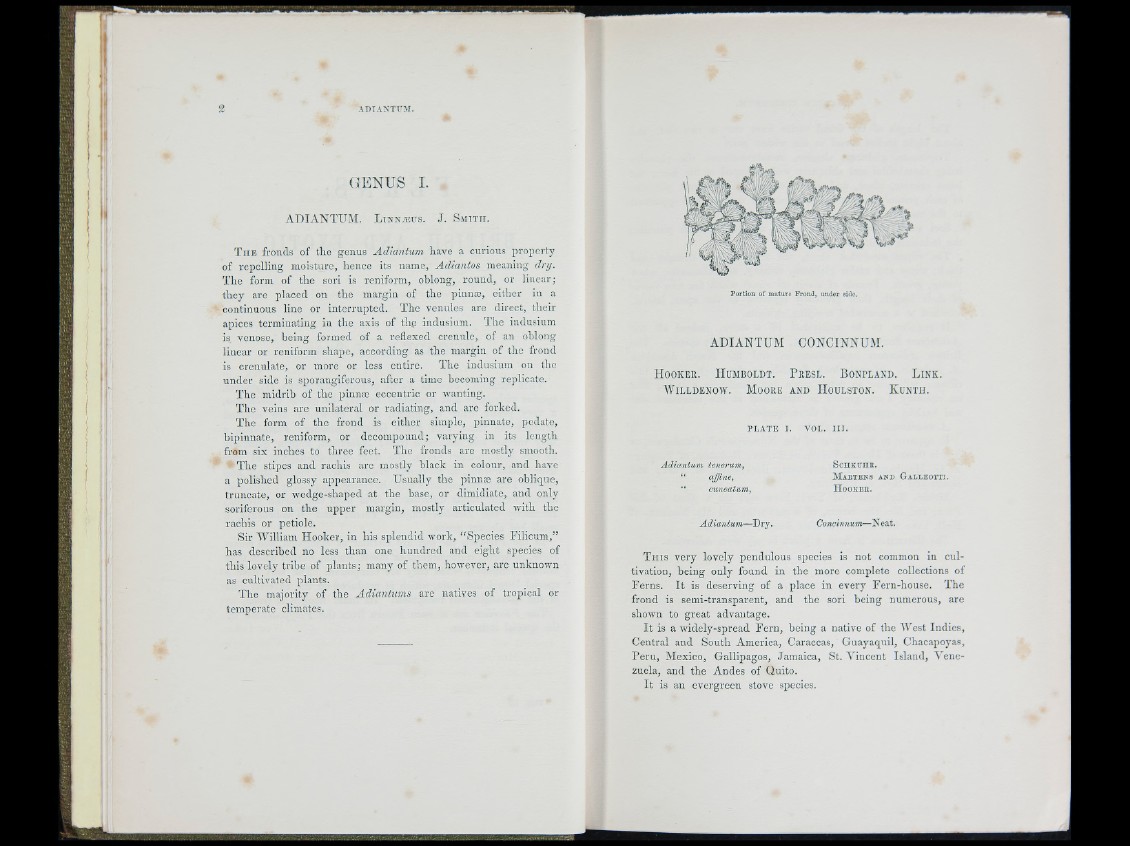
/ ‘ GENUS I.
A D IA N T U M . L i k n .tstjs. J . S m i t h .
T h e fronds of the genus A d ia n tum have a curious property
of repelling moisture, hence its name, A d ia n to s meaning dry.
T h e form of the sori is rcniform, oblong, ro u n d , or lin e a r;
th ey are placed on the margin of th e pinntc, e ither in a
continuous lino or in te rru p ted . T h e venules are direct, their
apices te rmina ting in the axis of the indusium. T h e indusium
is venose, being formed of a rcilexed crcnulc, of an oblong
linear or rcniform shape, according as the margin of the frond
is crenulate, or more or less entire. T h e indusium on the
u n d e r side is sporangiferous, after a time becoming replicate.
T h e midrib of the pinnrc eccentric or wanting.
T h e veins arc u nilateral or radiating, and are forked.
T h e form of the frond is e ith e r simple, p innate, pedate,
hip in n a tc , rcniform, or decompound; varying in its length
from six inches to th re e feet. The fronds are mostly smooth.
T h e stipes and rachls are mostly black in colour, and have
a polished glossy appearance. Usually the pinme are oblique,
tru n c a te , or wedge-shaped at the base, or dimidiate, and only
soriferous on th e u p p e r margin, mostly articulated with the
rachis or petiole.
Sir IVllliam H o o k e r, in his splendid work, “ Species F ilicum ,”
has described no loss th an one h u n d re d and eight species of
this lovely tribe of plan ts; many of them, however, are unknown
as cultivated plants.
T h e majority of the A d ia n tum s are natives of tropical or
temperate climates.
ADIANTUM CONCINNUM.
H o o k e r . H um b o l d t . P r e s l . B o n r l a k d . L i .n k .
WiLLDENOw. M oore a n d H o u l s t o n . K u n t i i .
PLATE I . VOL. I I I .
Adiantum tenerum,
“ affine,
“ cuneatum.
Adiantum—Dry.
ScHKCTHK.
Maetens and Galleotti.
IIOOICEE.
Concinnum—TH eat.
T h i s v ery lovely pendulous species is not common in cultivation,
being only found in the more complete collections of
F erns. I t is deserving of a place in every Fern-house. The
frond is semi-transparent, and the sori being numerous, are
shown to gre a t advantage.
I t is a widely-spread F e rn , being a native of the We st Indies,
Central and South America, Caraccas, Guayaquil, Chacapoyas,
P e ru , Mexico, Gallipagos, Jamaica, St. Vin c en t Islan d , A'ene-
zuela, and the Andes of Quito.
I t is an evergreen stove species.